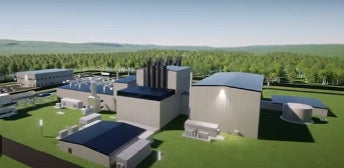
US-based TerraPower says it is confident its first Natrium advanced reactor will be built by 2030. Construction plans and licensing is proceeding as planned, but fuel supply remains a concern, the company said, according to a Reuters report.
The Natrium technology is a TerraPower and GE-Hitachi technology featuring a 345 MWe liquid sodium-cooled fast reactor with a separate molten salt-based energy storage system. The storage technology is intended to boost the system’s output to 500 MWe for more than five and a half hours when needed to integrate with variable renewable energy sources. Along with PacifiCorp and GE Hitachi Nuclear Energy, members of the demonstration project team include engineering and construction partner Bechtel, Energy Northwest, Duke Energy and nearly a dozen additional companies, universities and national laboratory partners. Natrium is one of two competitively-selected Advanced Reactor Demonstration Program (ARDP) projects supported by the US Department of Energy (DOE).
The company had originally hoped to commission the plant in 2028 using Russian-supplied high-assay low-enriched uranium (HALEU) fuel to get the demonstration unit up and running by 2028. The conflict in Ukraine, and recent moves to ban imports of Russian enriched uranium, however, have made continuing Russian HALEU deliveries unlikely and the US has yet to develop its own supplies. The projected commissioning date was therefore pushed to 2030.
In November 2021, TerraPower, founded by Bill Gates, announced an ageing coal plant owned by US PacifiCorp, in Kemmerer, Wyoming, as the preferred site for the Natrium reactor demonstration project. In March, NRC issued new guidance documents to facilitate the licensing of non-light water reactor designs. The guidance is expected to significantly reduce the regulatory uncertainty for new reactor concepts that differ from conventional reactor technologies.
According to Reuters, fuel supply remains TerraPower’s main concern for the first plant, on which the company expects to begin non-nuclear-related construction in June. Director of External Affairs at TerraPower Jeff Navin said the supply of HALEU was considered the greatest uncertainty when planning for deployment. “We still think 2030 is our best bet as to when we can get things completed, but I can’t tell you today that I can account for every kilogram of HALEU that we will need, where it will come from, and when we’ll have it, so that that is certainly something that still keeps us up at night.”
Plans for US-produced fuel are being expedited, including a two-phase project to produce 900 kg of HALEU a year by the nuclear fuel and services company, Centrus. In November 2023, Centrus announced its first delivery of 20 kilograms of HALEU uranium hexafluoride (UF6), completing Phase 1 of the HALEU Operation Contract under budget and ahead of schedule. Centrus has so far achieved cumulative deliveries to the DOE of approximately 135 kilograms of HALEU. However, this is not enough.
“We feel very confident that there will be multiple enrichers making HALEU in the United States in the future,” said Navin. “The question is how quickly they will be put in place for us to meet our initial core load for our first reactor. We just need more centrifuges spinning as quickly as possible to increase the amount of HALEU that’s commercially available.”






